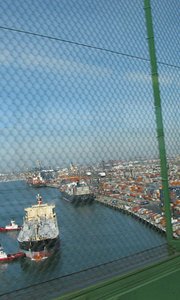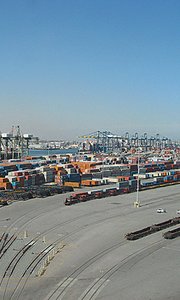Learning New Customs
Importers prepare for customs’ new security rules
The government’s new security rules for importing goods by air, rail and truck are keeping many in the apparel industry on their toes as they try to figure out how the changes will affect their businesses.
The government will hammer out the new regulations by Oct. 1 and will implement them within 90 days after their finalization. While the rules probably will not hamper imports during the holiday season, they will make importing a little more challenging in this era of just-in-time deliveries.
“We won’t have a dock strike this year like last year, so I guess the government thought we needed something else,” noted Ed Redding, executive vice president in charge of importing and sourcing at Calabasas, Calif.–based women’s apparel maker John Paul Richard Inc.
Redding was referring to the 10-day lockout of dockworkers at West Coast ports that ended Oct. 9, 2002, when a judge ordered the Pacific Maritime Association, which represents shipping lines and terminal operators, to reopen the ports for 80 days. The lockout came on the heels of an alleged work slowdown by International Longshore & Warehouse Union workers during contract negotiations between the union and the Pacific Maritime Association.
The lockout created havoc during the holiday season. Dozens of container ships waited to be unloaded beyond the breakwater of the ports of Long Beach and Los Angeles. Many apparel manufacturers had to spend extra money to air freight their goods to meet retailers’ deadlines.
Now the apparel industry must prepare for the U.S. Bureau of Customs and Border Protection’s new regulations, released July 23, for shipping goods by land, air and rail.
The new proposals follow on the heels of the ocean-cargo regulations that went into effect Feb. 2. Those regulations require ocean carriers to report cargo data 24 hours before a ship leaves for the United States. Both sets of rules are key parts of the government’s Container Security Initiative.
The newest cargo regulations require air carriers handling imports from overseas to electronically transmit cargo data four hours before a plane’s arrival in the United States. Rail carriers must transmit data two hours before arriving at their U.S. destinations. And truck carriers must forward information 30 minutes to one hour before reaching the border. Air carriers coming from Latin America must send their information upon takeoff.
The Bureau of Customs and Border Protection, part of the newly formed Department of Homeland Security, is allowing a 30-day period for companies to comment on the new regulations before lawmakers write the final versions. Comments must be in writing. Details can be found on the bureau’s Web site, www.cbp.gov.
Security vs. speed
The proposal of new shipping regulations is another step the government has taken to safeguard the country after the Sept. 11 terrorist attacks killed more than 3,000 people in three separate locations. Before, carriers and freight forwarders could deliver cargo information upon arrival.
The new rules have many people concerned. As China has stepped up to become a key player in the U.S. apparel industry, the ability to import goods quickly has become more important than ever.
Apparel manufacturers note that just-intime deliveries, which have become increasingly popular to cut down on warehousing time, leave little room for delay.
“If we are air freighting something, it’s because we don’t have a couple of days to play around with,” said Redding of John Paul Richard.
Vera Campbell, president of 21-year-old Los Angeles apparel company Design Zone Inc., noted that customs procedures have gotten slower. The government has passed more regulations and required more inspections of goods but has not put enough customs inspectors on the job, she said.
“Customs in general is getting tougher,” she said. “But truly, if you’ve done your homework and your documents are done properly, it shouldn’t pose a problem.”
Changing procedures
Freight forwarders and customs brokers are not too happy with the regulations. They do note, however, that the new proposals are better than what the government had previously suggested. Initially, the customs bureau had considered having all air-cargo manifests sent electronically at least 12 hours before takeoff.
“This whole thing is very restrictive,” said Guy Fox, head of the Los Angeles Air Cargo Association and executive vice president of Philadelphia-based Stonepath Logistics, a freight forwarder and customs broker with offices in Redondo Beach, Calif.
Already the new regulations on ocean cargo have required that customs brokers and freight forwarders spend a tremendous amount to buy and set up new software to electronically send manifests from overseas to U.S. customs inspectors. Carriers previously handled much of this work.
“It really slows down the process,” Fox said. “We’re doing 10 times the amount of work hellip; I think you are going to find these rules are by people who just don’t understand the process. If they were in the trenches, they would understand.”
Robert Krieger, president of Norman Krieger Inc., a freight forwarder and customs broker in Los Angeles, said that any new cargo regulations create some chaos.
For example, he said, the government requires the name and address of the shipper to be on the manifest. But if a garment is cut in one factory, sewn in a second factory and pressed in a third, whose name should appear on the papers?
Betsy Durant, executive director of trade compliance facilitation at the Bureau of Customs and Border Protection, said the definition of a shipper is mentioned in the regulations. The government, she said, will not be that picky about who is listed as the shipper.
Krieger also has concerns about what would happen if one shipment of imported goods did not have the right documentation forwarded at the time of the plane’s arrival.
“What is customs going to do when the plane arrives?” Krieger asked. “Are they going to cordon off the aircraft or take the goods off that are not properly documented?”
Durant said an entire planeload of goods probably would not be isolated—unless customs officials had reason to believe there was something “really terrible” on board. Imports are held according to their bills of lading and not by entire cargo loads, she said.
Importers could, however, run into problems if a consolidated shipment of imports had one missing manifest.
“If a consolidation was on the same bill of lading, then somebody’s stuff could get held up,” she noted.
Durant said there are still a number of issues that have to be worked out.
“With the 24-hour rule for ocean cargo, we had a phase-in implementation of the rule and a lot of hand holding at the beginning,” she said. “I would expect we would have a similar transition period for this.”
Air Cargo at Los Angeles International Airport Los Angeles International Airport is the world’s fifth-busiest cargo airport. The airport handled more than 1.96 million tons of air cargo last year.
Year Air Mail Tons Air Freight Tons Total Air Cargo1991 162,840 1,095,580 1,258,2091992 162,840 1,202,317 1,365,1571993 173,827 1,288,503 1,462,3301994 186,878 1,516,567 1,703,4451995 193,747 1,567,248 1,760,9951996 194,091 1,696,663 1,895,7541997 212,410 1,852,487 2,064,8971998 264,473 1,790,949 2,055,4221999 253,695 1,884,526 2,138,2212000 246,538 2,001,295 2,247,8332001 178,072 1,778,267 1,956,3402002 92,422 1,869,932 1,962,354Source: Los Angeles World Airports























